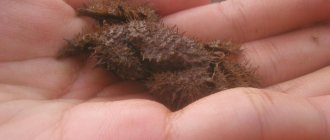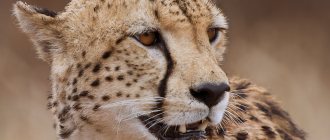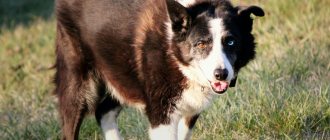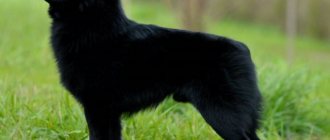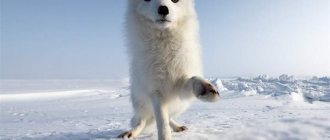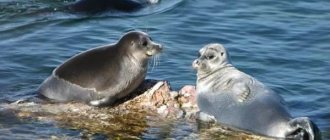Tundra is a natural ecosystem located at the North Pole. It is included in the biome surrounding the Arctic Circle, which is also the coldest on Earth. The natural tundra zone is located in the center of the North Pole, but there are other parts that are included in its territory because they have the same climatic conditions. These regions include the Arctic, parts of Alaska and northern Canada. In the tundra, the average temperature in winter is -34° C, and in summer it ranges between +3° and +12° C.
The tundra territory warms up only for two months of the year. But despite the extreme cold, the tundra biome is rapidly developing. A wide variety of flora and fauna can be found here. Plants found on the tundra are concentrated quite densely in order to protect themselves from the harsh northern winds. Animals of the tundra hibernate for a significant part of the year or migrate to warm regions. The list below is dedicated to the fauna of the tundra.
polar fox
Arctic fox (Arctic fox) - distributed throughout the Arctic region. The diet consists of small mammals, including voles and lemmings, as well as birds and their eggs. Arctic foxes are opportunists and will sometimes feed on dead animal carcasses. They often follow behind polar bears to feed on the predators' remains. Arctic foxes also eat some plant foods such as berries.
Like many other foxes, arctic foxes build burrows. They can be located on hillsides or river banks, and usually have several entrances and exits. Arctic foxes can be found in the arctic or alpine tundra.
Arctic foxes are adapted to live in extremely cold climates. They have fur on their paws to keep them warm, a thick and dense layer of fur around their body, short ears, a small body size, and a large, bushy tail that foxes wrap around themselves.
Climate
A constant factor shaping the tundra is the alternating freezing and thawing of the soil. This freeze-thaw cycle distinguishes the tundra from two other ecosystems often found alongside it - the icy polar wastes on one side and the evergreen taiga on the other. Permafrost—permanently frozen ground—is an important feature of the Arctic tundra; however, in the alpine regions things are different.
The climate of the tundra varies significantly. For example, in Arctic regions, temperatures range from 4 °C (about 40 °F) in midsummer to –32 °C (–25 °F) during the winter months. The alpine tundra has a more temperate climate, with cool summers with temperatures ranging from 3 to 12 °C (37 to 54 °F) and mild winters, with temperatures rarely falling below −18 °C (0 °F). .
The Arctic tundra is characterized more by low summer temperatures than by low winter temperatures. Late summer and early fall are particularly cloudy seasons because there is a large amount of water available for evaporation. However, with the first winter frosts, clear skies return.
Over much of the Arctic tundra, annual precipitation, measured as liquid water, is less than 38 cm, with about two-thirds falling as summer rain. The rest falls as snow, the height of which can range from 64 cm to more than 191 cm. Heavy snowstorms are frequent guests in the winter months, and summer rains are quite heavy. However, the stratification of the soil and the slope of the alpine slopes provide good drainage.
Although winds in the Arctic are not as strong as in the alpine tundra, their influence on snow drift patterns is an important climatic factor.
killer whale
The killer whale is a marine predator and the largest representative of the dolphin family, perfectly adapted to living in the harsh climate of the tundra. This is a very intelligent and highly adaptable animal. Killer whales live in all oceans of the world. They have been spotted from the northern Arctic Ocean to the southern Southern Ocean. They prefer cold waters. If food becomes scarce, killer whales swim to other areas with sufficient food supply. Their diet consists of: seals, sea lions, small whales, dolphins, fish, sharks, squid, octopuses, sea turtles, seabirds, sea otters, river beavers and other animals. High-calorie nutrition helps build an insulating layer of fat, making it easier to survive in the cold waters off the tundra coast.
The average body length of an adult male is 8 meters, and that of a female is 7 meters. The weight of males is about 7200 kg, and females are slightly less.
Killer whales are very social animals, their groups number up to 50 individuals. They share food with each other and leave their pack for no more than a few hours.
Sea lion
The sea lion is a marine mammal characterized by small ears, long and wide front flippers, the ability to walk on all fours, and short, thick fur. The front flippers are the main means of propulsion in the water. Their range extends from subarctic to tropical waters of the world's oceans, in the northern and southern hemispheres, with the exception of the North Atlantic Ocean. The average life expectancy is 20-30 years. The male sea lion weighs about 300 kg and has a body length of 2.4 meters, while the female weighs 100 kg and has a body length of 1.8 meters. Sea lions consume large amounts of food, about 5-8% of their body weight per feeding. The diet consists of: fish (e.g. capelin, cod, herring, mackerel, pollock, sea bass, salmon, sand lance, etc.), bivalves, cephalopods (e.g. squid and octopus) and gastropods. Under the animal's skin there is a thick layer of fat, and along with thick hair, it protects the animal from the harsh climatic conditions of the tundra.
These animals are capable of diving deeply underwater (up to 400 meters), and through many inherent physiological processes (heart rate, gas exchange, digestion rate and blood flow), the animal's body copes with the high pressure caused by diving.
The terrestrial lifestyle is used for resting, molting and reproduction. Sea lions may come onto land to bask in the sun.
Fauna of the tundra
The harsh world of the tundra is beautiful, rich and attractive. In Russia, this natural zone covers the territory from the Kola Peninsula and extends to Chukotka. Outside our country, it is located in the northern part of Eurasia and North America.
Life in this icy desert without forests, with frozen soil, and strong winds seems impossible. But even here the world is surprisingly resilient and diverse. The names of tundra animals have become symbols of power, fearlessness, insight, strength, beauty: wolf, walrus, peregrine falcon, owl, swan.
American ground squirrel
The American ground squirrel is a species of small rodent from the squirrel family. It is found in the tundra and is preyed on by foxes, wolverines, lynxes, bears, and eagles. In summer it feeds on tundra plants, seeds and fruits to increase fat before hibernation. Towards the end of summer, male ground squirrels begin storing food in their burrows so that they have something to eat in the spring until new vegetation grows. The burrows are covered with lichens, leaves and musk ox hair.
During hibernation, the ground squirrel's brain temperature drops to near freezing, body temperature reaches -2.9°C, and heart rate drops to ~1 beat per minute. The temperature of the colon and blood becomes sub-zero. Hibernation for adult males lasts from late September to early April, and for females - from early August to late April. Body temperature decreases from 37° C to – 3° C.
The coat color changes depending on the time of year. The fur is soft and velvety, and protects the animal from cold winds.
Its homeland is the North American Arctic tundra, and its main habitats are on mountain slopes, river bottoms, lake shores and mountain ranges. Gophers prefer sandy soil because of easy digging and good drainage.
Lemming
The lemming is a small rodent that usually lives in or near the Arctic, in the tundra biome. The animal's body weight is from 30 to 110 g, and its length is 7-15 cm. As a rule, lemmings have long, soft fur and very short tails. They are herbivores, feeding mainly on leaves and shoots, grass and sedges, as well as roots and bulbs. From time to time, they eat larvae. Like other rodents, their incisors grow continuously.
Lemmings do not hibernate due to the harsh northern winter. They remain active and search for food under the snow, or feed on food preparations. They are solitary animals by nature, and only meet to mate and then go their separate ways, but like all rodents, they have a high reproductive rate and breed often when food is plentiful.
Ecological problems
Industrial activity has a negative impact on the balance of the tundra ecosystem.
Threats to the natural area include the following:
- due to the construction of buildings and vehicle exhaust gases, the permafrost layer is melting, which leads to changes in natural systems;
- mining harms the environment;
- the reduction in the areas of “reindeer moss” or moss due to human activity ultimately leads to a disruption of the food chain pattern in the tundra;
- increased ultraviolet radiation as a result of a decrease in the ozone layer at the North Pole;
- The activities of poachers lead to a reduction in wildlife.
In addition to the consequences of human activities, it is difficult for animals and plants to survive due to harsh climatic conditions and widespread waterlogging, which leads to the destruction of soil cover.
Environmental protection
The tundra ecosystem is very fragile, so to preserve it it is necessary to take measures to protect this natural area.
Environmental and environmental organizations are developing special solutions for the protection of northern flora and fauna:
- creation of national parks and reserves to preserve untouched areas of nature;
- ban on illegal hunting;
- use of environmentally friendly mining equipment;
- taking under protection rare species of animals and plants;
- In order to maintain vegetation cover, caribou herds are periodically moved to another location.
The tundra is a place where unique species of plants and animals live. This northern world must be protected and preserved in its original form.
Seal
There are many species of seals that live in the tundra, including the harp seal (Pagophilus groenlandicus), long-snouted seal (Halichoerus grypus), Weddell seal (Leptonychotes weddellii), elephant seal (Mirounga) and striped seal (Histriophoca fasciata). Seals are excellent swimmers, diving deep into Arctic seas to hunt fish, but coming to land to breed, socialize, and give birth to their young. Thanks to their thick fat deposits and waterproof coat, they are well adapted to living in cold conditions.
Seals hold their breath underwater for long periods of time and dive very deep, allowing air to escape from their lungs. Weddell seals can hold their breath for up to an hour. Many species often remain under the ice, which helps them avoid predators such as polar bears. Most seals molt during the warmer months, and some tundra-dwelling species migrate to warmer seas to molt.
Meaning
The cold and endless expanses of the tundra, despite the apparent barrenness, store many resources.
Among the minerals we can list the following:
The main economic activity is reindeer breeding. It is too cold for farming and growing crops in these places. The fact that a huge amount of carbon is retained in the frozen depths of the tundra soil suggests that thanks to this natural zone, climatic balance in the atmosphere is maintained.
Belukha
The beluga whale is a white representative of toothed whales from the narwhal family (Monodontidae). This animal is well adapted for life in cold waters due to a number of anatomical and physiological features. Among them are white color and the absence of a dorsal fin. The beluga whale has a distinctive bulge on the front of its head, which houses a large and deformable echolocation organ. Males grow up to 5.5 meters in length and weigh about 1600 kg. Beluga whales have a stocky body and well-developed hearing.
They are social animals, forming groups of up to 10 individuals on average, but in the summer they can gather in groups of hundreds or even thousands of beluga whales. They are slow swimmers, but have the ability to dive under water up to 700 meters. Their diet depends on their location and season. Beluga whales are migratory and most groups spend the winter near the Arctic cap; when the ice melts in the summer, they move to warmer estuaries and coastal areas. Some groups are sedentary and do not migrate long distances during the year.
Summer paradise for waterfowl
In summer, the endless expanses of the tundra are literally saturated with water. These include melted snow waters, numerous lakes, swamps, and rivers. Therefore, the fauna of the tundra is replenished with a huge number of waterfowl. They find algae and insect larvae in the water, and they do not refuse the insects themselves.
Geese, ducks, loons, waders, swans - this is not a complete list of birds that feed and raise their chicks in the far north. And in the fall they take their chicks south, to warmer climes.
Elk and reindeer
Elk and reindeer are members of the deer family (Cervidae). Male moose have characteristic branched antlers, while reindeer have antlers in both sexes. Both species are widespread in various climatic zones, including the tundra. They feed on vegetation (bark, leaves, grass, buds, shoots, moss, mushrooms).
Thanks to the structure of their hair and thick hair, as well as a thick layer of subcutaneous fat, these deer are adapted to living in the cold climate of the tundra. They are able to move on loose snow and raise their legs high when walking. When moving, they use walking or trotting (they very rarely gallop).
When the snow depth is more than 70 cm, they move to less snowy areas.
Literature
When preparing the article, materials from the books were used:
- Great Soviet Encyclopedia. (In 30 volumes.) Ch. ed. A. M. Prokhorov. Ed. 3rd. M., “Soviet Encyclopedia”. 1977. T. 26 Tardigrades - Ulyanovo. 1977. 624 p. from illus.
- Soviet Union. Geogr. description in 22 volumes. Russian Federation: General overview and the European North. Rep. ed. S. V. Kalesnik, A. V. Darinsky. M.. “Thought”, 1971. 565 p. from illustration, map. and diagram
- Orlyonok V.V., Kurkov A.A., Kucheryavyi P.P., Tupikin S.N. Physical Geography: Textbook / Ed. V.V. Eaglet. Kaliningrad, 1998. – 480 p.
- Physical Geography: Reference. materials: Book. for middle school students and Art. age / A.M. Berlyant, I.V. Dushina, N.P. Neklyukova, E.M. Rakovskaya. – 2nd ed. – M.: Education, 1995. – 288 p.: ill.
- Encyclopedia for children. T. 3. Geography. – 3rd ed., revised / Chapter. ed. M. D. Aksenova. – M.: Avanta+, 1997. – 704 p.: ill.
Arctic hare
The Arctic hare, or arctic hare, is a species of hares that is adapted to life in polar and mountain habitats. It has short ears and limbs, a small nose, body fat that accounts for 20% of its body weight, and a thick layer of fur. To maintain warmth and sleep, polar hares dig holes in the ground or under the snow. They look like rabbits, but have shorter ears, are taller when standing, and, unlike rabbits, are able to live in very cold temperatures. They may travel with other hares, sometimes in groups of 10 or more, but are usually found alone except during the breeding season. The Arctic hare can reach speeds of up to 60 kilometers per hour.
The hare is one of the largest representatives of lagomorphs. On average, individuals weigh from 2.2 to 5.5 kg (although there are large hares weighing up to 7 kg), and have a body length of 43-70 cm, not counting the tail length of 4.5-10 cm.
Arctic whites feed on vegetation, 95% of their diet consists of willow, the rest includes moss, lichens, sedge, bark, and algae. Sometimes they eat meat and fish.
Polar bear
The white or polar bear is one of the largest land mammals. Males weigh 370-700 kg, height at the withers is from 240 to 300 cm. Females are smaller than males, with an average weight of 160-320 kg. Polar bears appear to have white fur; however, their hairs are transparent and their skin is black. The fur and skin are adapted to absorb sunlight and maintain a high body temperature. Like many other animals of the Arctic and tundra, polar bears have short ears, which minimizes heat loss.
Polar bears often locate near water and ice where their favorite food, seals, is found. Bears have burrows in which they sleep and where females give birth to their cubs. These predators do not hibernate as this is the hunting season, however, some individuals and pregnant females in particular go into deep winter sleep, during which the heart rate decreases significantly.
Melville Island wolf and tundra wolf
Melville Island and Tundra wolves are subspecies of the gray wolf that live in the tundra. The fur of tundra wolves is darker than that of polar wolves. Both subspecies have long, thick and soft hair. The tundra subspecies is found on the mainland, while arctic wolves live on the ice itself because they are able to better camouflage themselves from potential prey thanks to their snow-white fur. These wolves hunt in packs of 5-10 individuals. Arctic wolves hunt musk oxen, caribou and Arctic hares. They also eat lemmings, birds and ground squirrels. Polar wolves are slightly larger than tundra wolves and have small ears, which allows them to retain heat better.
The structure of the paws, namely the presence of small membranes between the toes, allows them to easily move through deep snow. They are digitigrade, so their body weight is balanced. Blunt claws help maintain balance on a slippery surface, and the circulatory system protects the limbs from hypothermia. The fur of these wolves has low thermal conductivity, which helps them survive in the harsh climatic conditions of the tundra.
Mammals
Many species of mammals live in tundra zones. These are mainly herbivores, accustomed over millions of years of existence in such conditions to be content with sparse vegetation. But there are also predators that hunt them, as well as omnivores.
Reindeer
These artiodactyls are considered one of the main inhabitants of the tundra. Their body and neck are quite long, but their legs look short and slightly disproportionate. Due to the fact that the deer constantly has to lower its head and neck low in search of food, it may appear that it has a slight hump.
Reindeer do not have the elegance of lines and graceful movements that distinguish their related species living further south. But this herbivore has a peculiar beauty: its entire appearance is an expression of strength, confidence and endurance.
Reindeer have large, branched antlers on their heads, and both males of this species and females have them.
His coat is thick, dense and elastic. In winter, the fur becomes especially long and forms a characteristic small mane and feathering along the lower body and around the hooves. The hair coat consists of a strong and dense awn, under which there is also a thick, but very thin undercoat.
In summer, the color of reindeer is coffee-brown or ash-brown, but in winter, the color of the fur becomes more variegated, lightened to white, as well as strongly darkened areas appear in it.
Due to the fact that their sweat glands are undeveloped, reindeer are forced in the summer, when it gets hot for them, to constantly keep their mouth open in order to at least regulate their body temperature.
The special structure of the hooves, in which the joints of the fingers can bend, as well as the “brush” made of wool, which prevents injury to the legs and, at the same time, increases the area of support, allows the animal to easily move even on very loose snow.
Thanks to this, reindeer can migrate across the tundra in search of food at any time of the year, with the possible exception of those days when there are strong snowstorms.
Their life cannot be called easy, since these animals have many enemies in the tundra. In particular, reindeer are hunted by bears, wolves, arctic foxes and wolverines. If the deer is lucky, it can live up to 28 years in natural conditions.
Caribou
If the ordinary reindeer inhabits the tundra regions of Eurasia, then the caribou is an inhabitant of the tundra of North America. It is not much different from its Eurasian relative, except that caribou refers to wild reindeer. Previously, countless herds of these animals roamed the north of the American continent. But to date, the caribou population has greatly decreased.
In North America, the following subspecies of caribou live in the tundra:
- Greenland caribou
- Grant's Caribou
- Caribou Peary
Interesting! Caribou remained wild because the aborigines of North America did not domesticate them, as the tribes living in northern Eurasia once did, domesticating the reindeer.
bighorn sheep
An animal of strong build and medium size, which is a representative of the genus of sheep from the order Artiodactyls. The head is small, the ears are also relatively small, the neck is muscular, powerful and rather short. The horns are strongly curved, voluminous and embossed. The shape resembles an incomplete ring. Their base is very thick and massive, and closer to the ends the horns narrow greatly and begin to bend slightly to the sides.
Bighorn sheep live in mountainous regions, and this animal does not settle in areas where the height of the snow cover exceeds 40 centimeters, and too dense crust is also not suitable for them. Their distribution area covers Eastern Siberia, but it consists of several separate centers where populations of this animal live.
Interesting! It is believed that bighorn sheep appeared in Siberia about 600,000 years ago, at a time when Eurasia and America were connected by the later disappeared Bering Land Bridge.
It was through this isthmus that the ancient ancestors of bighorn sheep moved from Alaska to the territory of Eastern Siberia, where they later formed a separate species.
Their closest relatives are American bighorn sheep and Dall sheep. Moreover, the latter are also inhabitants of the tundra, albeit North American: their range extends from southern Alaska to British Columbia.
Muskox
The ancestors of this animal once lived in the mountains of Central Asia. But about 3.5 million years ago, when it got colder, they settled throughout Siberia and the northern part of Eurasia. Also, through the Bering Isthmus they reached Alaska, and from there they reached Greenland.
Musk oxen look very impressive: they have a strong and stocky body, large heads and relatively short necks. The body of these herbivores is covered with very long and thick four-layer wool, forming a kind of cloak, moreover, its undercoat is thick, soft, and its warmth is eight times greater than sheep's wool. The horns of musk oxen are quite massive near the base, having a rounded shape and tapering to pointed ends.
Most musk oxen are social animals, they live in small herds consisting of females with cubs and young males. Adult males can live separately, and during the rutting period they try to forcefully take away harems from younger rivals, who, in turn, actively protect them.
Lemming
A small rodent that looks like a mouse and belongs to the hamster family. It is lemmings that form the basis of the food supply of most predators living in the tundra.
This is a small creature, whose size together with the tail does not exceed 17 cm, and whose weight is 70 grams, mainly leads a solitary lifestyle. The life expectancy of lemmings is short, and therefore, these animals, already at the age of six weeks, males are suitable for reproduction. Females give birth to their first litter at the age of 2-3 months, and in just a year she can have up to six litters, each numbering 5-6 cubs.
Lemmings feed on plant foods: seeds, leaves and roots of dwarf trees. They do not hibernate, but in the summer they build pantries where they hide supplies of food, which they eat during the period of lack of food. If food supplies in a particular area run out, for example, due to crop failure, lemmings have to migrate to new territories where the food supply has not yet been depleted.
The following types of lemmings live in the tundra:
- Norwegian Lemming
- Siberian lemming
- Hoofed lemming
- Lemming Vinogradova
All of them are colored predominantly in shades of reddish-brown, complemented by darker markings, for example, black or grayish.
Interesting! The hoofed lemming differs from its relatives not only in its dull grayish-ashy color with reddish tints, but also in the fact that the two middle claws on its forelimbs grow, forming something like a wide forked fork.
American ground squirrel
Despite their name, American ground squirrels are common inhabitants of the Eurasian taiga, and, for example, in Chukotka, you can often meet them. In the north of Russia, these animals, belonging to the squirrel family, have their own and at the same time quite funny name: here they are called evrashki.
Gophers live in colonies, each of which includes 5-50 individuals. These animals are practically omnivores, but most of their diet consists of plant foods: rhizomes or plant bulbs, berries, shoots of shrubs and mushrooms. Due to the fact that gophers require a lot of energy in cold climates, they are also forced to eat caterpillars and large insects. In extreme cases, they can feed on carrion, pick up food scraps, or even hunt their own relatives, although, usually, Europeans are quite friendly towards each other.
American ground squirrels are active only in the summer; for the remaining 7-8 months they are in a state of hibernation.
Arctic hare
One of the largest hares: its body length reaches 65 cm, and its weight is 5.5 kg. The length of his ears is less than, for example, that of a hare. This is necessary in order to reduce heat loss in harsh climates. The paws are relatively wide, and the pads of the toes and feet are covered with thick hair, forming something like a brush. Thanks to these structural features of the limbs, the white hare can easily move on loose snow.
The hare got its name because in the winter season its color is pure white, except for the blackened tips of its ears. In summer, the white hare is colored grayish or gray-brown. This seasonal change in color helps it survive by camouflaging itself with the color of its environment, so that in winter it is difficult to see it in the snow, and in summer it is difficult to see on the ground covered with tundra vegetation.
Red fox
In the tundra, the fox feeds on lemmings, but on occasion it is not averse to snacking on other prey. These predators do not catch hares very often, but bird eggs and chicks are often in their diet.
Foxes that live near large rivers during the spawning season feed mainly on salmon fish that have weakened or died after spawning. These dogs do not disdain lizards and insects, and during periods of lack of food they can also snack on carrion. However, foxes also need plant food. That is why they eat berries or plant shoots.
Foxes living near populated areas and tourist centers not only visit nearby garbage dumps in order to profit from food waste, but can also beg for food from people.
Tundra and polar wolves
The tundra wolf is distinguished by its large size (weight reaches 50 kg) and very light, sometimes almost white, long, soft and thick hair. Like all other wolves, representatives of this subspecies are predators.
They hunt rodents, hares and ungulates. A significant part of their diet is reindeer meat, therefore, tundra wolves often migrate after their herds. At one time the animal can eat up to 15 kg of meat.
Tundra wolves live in packs of 5-10 individuals; they hunt large game collectively, but if it is not in sight, they mouse, digging out lemming holes.
In areas of the Arctic tundra, musk oxen can also be attacked, but the meat of these ungulates is rather an exception than a normal part of their diet.
Interesting! In the tundra, especially in areas adjacent to the Arctic, the polar wolf, which is particularly large in size, is also found.
Its height is 80-93 cm at the withers, and its weight can reach up to 85 kg. The most characteristic external features of these predators are small, rounded ears, almost white coat color and a long, bushy tail. Polar wolves hunt mainly lemmings and hares, but to survive they also need larger prey, such as reindeer or musk oxen. These predators live in flocks of 7 to 25 individuals.
Arctic fox
A small predator of the canine family, similar in appearance to a fox. There are two color options for this animal: regular, white and so-called blue. In winter, the white fox has fur that can be compared with freshly fallen snow, while the blue fox has darker fur - from sandy-coffee to bluish-steel or silver-brown. Blue foxes are rare in nature, and therefore are highly valued among hunters.
Arctic foxes prefer to live in the hilly tundra, where they dig holes on the sandy slopes of hills, which are rather complex and sometimes intricate underground passages.
It mainly feeds on lemmings and birds, although it is essentially omnivorous. Sometimes arctic foxes even dare to attack baby reindeer that have strayed from the herd. On occasion, they will not miss the opportunity to eat fish, which they can either simply pick up that has already washed up on the shore, or catch it themselves.
Despite the fact that the arctic fox is a valuable fur-bearing animal, hunters do not like it because this predator steals their prey caught in traps.
Ermine
Another predator living in the tundra. The stoat is a small animal of the mustelidae family. It has an elongated body and neck, shortened legs and a head shaped like a triangle. The ears are small, rounded, the tail is relatively long with a black tip, characteristic of this animal, resembling a brush.
In winter, the ermine's fur is snow-white except for the black tip of the tail. In summer, this animal is colored in shades of reddish-brown, and its belly, chest, neck and chin are whitish-cream.
The stoat feeds on small rodents, birds, lizards, amphibians, and fish. Can attack animals larger than it, for example, hares.
Despite their small size, stoats are distinguished by unprecedented courage and determination, and if they find themselves in a hopeless situation, they will not hesitate to rush even at people.
Polar bear
The largest and, perhaps, the most powerful and dangerous predator of the tundra. Mainly lives in polar tundra regions. It is distinguished from other species of the bear family by its relatively long neck and flat head with a slightly hooked muzzle. The color of this animal’s thick and warm fur is yellowish or almost white; sometimes the fur takes on a greenish tint due to the fact that microscopic algae have settled in the cavities of the hairs.
As a rule, polar bears hunt seals, walruses and other marine animals, but they can eat dead fish, chicks, eggs, grass and algae, and near cities they rummage through garbage dumps in search of food waste.
Polar bears live in tundra zones mainly in winter, and in summer they migrate to colder Arctic regions.
Return to content
Ermine
The stoat is a small predator, a member of the mustelidae family. The body length including the head is 16-31 cm, and the weight is 90-445 grams. Sexual dimorphism is pronounced, males are larger than females. They have a long, thin, cylindrical body, short legs and a long tail. Individuals living in the tundra have thicker and lighter fur than their relatives from other climatic zones.
They have excellent eyesight, smell and hearing, which are used in hunting. Stoats are agile and good at climbing trees. They are also excellent swimmers, capable of crossing wide rivers. They move through the snow using jumps on their hind legs up to 50 cm in length.
They are carnivores and their diet consists of: rabbits, small rodents (such as voles), hares, birds, insects, fish, reptiles, amphibians and invertebrates. When food is scarce, they eat carrion (dead animal carcasses).
Muskox
The musk ox is a long-haired, herbivorous, horned mammal that lives in Alaska, Greenland, Canada, Sweden, Norway and Siberia. They reach a body length of 180 to 230 cm, and the height at the withers ranges from 120 to 150 cm. Their weight varies between 180-400 kg. Thanks to their incredibly long and thick fur, musk oxen are ideally adapted to life in northern conditions and can withstand the most severe frosts. Males and females have horns that start near the center of the skull. They have glands that produce a strong musky odor, which gives these bulls their name.
Musk oxen are vegetarians and feed on most of the vegetation that is available in the tundra (willow shoots, lichens, grasses and shrubs).
Musk oxen live in herds. The herd often stays in a specific area where food and water are available. If these resources are not available, animals will move within the range in search of food and drink necessary for life.
White or polar owl
The polar owl is a beautiful white bird from the owl family. The white plumage helps them hide in cold habitats. Only males are completely white; females and their young have dark spots on their bodies and wings. The feather color of males becomes whiter with age. Females are never completely white, but mature males are often 100% white. Their feathers are long and thick (even their claws are feathered), and are well suited to cold climates.
Snowy owls are one of the largest owls with a body length of about 71 cm and a weight of 3 kg. They are diurnal, unlike most other owl species, which means that most of their activity occurs during the daytime.
Snowy owls are carnivores, they have fantastic vision and hearing, which allow them to find prey hidden in thickets or under thick snow. Their preferred prey is lemmings, which they eat in huge quantities. An adult owl eats more than 1,500 lemmings a year, and supplements this diet with fish, rodents, rabbits and birds.
The snowy owl prefers to remain in its cold habitat for the entire year, but is known to migrate.
Birds
Ptarmigan
Outwardly it resembles a chicken and a pigeon. During the year, the female changes plumage three times, and the male four. This contributes to effective camouflage. The partridge flies poorly; it feeds mainly on plant foods. Before winter, the bird tries to eat worms and insects in order to stock up on fat for the winter.
polar owl
In the wild, the life expectancy of snowy owls reaches 9 years, and in captivity, some individuals break records and live up to 28 years. For a long time it was believed that the number of these birds was quite large, but only recently it became clear that their number is much smaller than expected. Currently, snowy owls are included in the list of protected animals.
Red-breasted Goose
Red-breasted geese are capable of reaching high speeds during flight by flapping their wings frequently. Being an extremely active and noisy bird, they form chaotic flocks, which sometimes stretch out in one line, sometimes huddling together. In the wild, these birds are easily recognized by their characteristic cackling and hissing sounds.
Pink seagull
This representative of gulls is notable for its characteristic soft pink color of feathers, which is combined with the blue tint of the head feathers. Despite their small size, these birds survive well in the tundra. Life expectancy reaches a maximum of 12 years. Listed in the Red Book.
Swift-winged gyrfalcon
Has a middle name - white falcon. In its dimensions it resembles a peregrine falcon. The plumage is usually white with a gray tint. Notable for its ability to reach speeds of up to 100 meters per second, and also has extremely acute vision. At the moment, this species is listed in the Red Book as in need of help and attention.
White-billed loon
Quite a large representative, with a body length of up to 91 centimeters and a weight of up to 6 kilograms. It is distinguished from other loons by its ivory-colored beak. The population of this bird is extremely low throughout its habitat. It is listed in the Red Book of the Russian Federation and is also protected in a number of Arctic reserves.
Yellowjacket
Represents the finch family. A small bird with a body length of up to 20 centimeters. Distinguished by its characteristic sandy plumage. As the only representative of the genus, Canadian sandpipers are a very rare species. Distributed throughout the tundra of North America. Spends the winter in Argentina or Uruguay.
Lapland plantain
A bird that lives in the northern tundra. It can be found in Siberia, Sweden, Norway and the northern part of Europe. Usually settles in areas covered with many plants.
The plumage is dull and colors vary from grayish to brown. There are stripes and small dark specks on the head and wings. By the breeding season, the Lapland plantain undergoes a noticeable transformation: quite a few black and white stripes appear on its body, the back of the head changes its color to red, thereby creating a noticeable contrast in comparison with the body.
When the snow just begins to melt, Lapland plantains begin building their nest. They collect tree roots, grass and moss from all over the area, and then cover the surface with dried grass and animal hair left after molting.
Bunochka
This bird has a second name - snow plantain, usually lives in the tundra zone of America and Eurasia. During the breeding season, males change their color to black and white, and females become black and brown with small gaps on the belly and chest, which can often be pure white. They have a light outline on their dark feathers. In winter, they change their color to adapt to their environment and be less noticeable to predators. It is in the browned grass that the buntings live in winter, as their color blends with them. In summer, this bird feeds on insects, and in winter it eats only grains and seeds.
Plover
Quite small birds from the waders family, in appearance quite similar to sparrows. They differ from them in their strong build, straight and short beak, as well as longer wings. They have short legs without hind toes. Basically, the color varies from gray to brown, but the underbelly is light gray or almost white. Sometimes they have stripes on their neck or head.
Plovers feed on invertebrates, and not in the most usual way: they run along the ground at high speed, looking for and catching their prey. They live in the northern parts of Africa and the Arabian Peninsula.
Tundra swan
The main habitat of tundra swans is considered to be the Asian part of the Russian tundra, as well as some part of Europe. They usually eat grass, berries, and aquatic vegetation, which these birds can reach without any problems thanks to their long necks. The eastern inhabitants of its range are disdainful of eating small fish that are found in shallow water, as well as aquatic invertebrates such as fry.
In appearance it is not particularly different from other swans, for example, from the whooper swans, but this species is considered one of the smallest in size among its fellows. All of them, without exception, are monogamous - their couple remains with them until death; only in extreme cases are there individuals who can show polygamy, but these are exceptions to the rule, since swans are considered a symbol of love until the grave. They build a nest using branches, dry leaves, and cover the inside with their down, creating a softer surface. Their place of residence is located on the hills. These birds leave their habitats in the fall, and in winter they go to Western Europe for the winter, since their bodies are not able to withstand severe cold.
Red-breasted Pipit
Living in the Eurasian part of the tundra and on the western shores of Alaska, the bird, which stands out among the rest with its variegated colors and small size, belongs to the wagtail family. It chooses swampy areas as a place to build a nest, and builds its place of residence directly on the ground. This arrangement prevents birds of prey that can fly over and eat the eggs, as well as predators that can climb trees, from eating the family or the pipit itself. Their colors are similar in shades to a swamp, so in summer or autumn it becomes problematic even for the human eye to notice them.
This bird got its name due to its memorable colors in certain places, which contrast very much with the rest of the body: their throat, sides, and chest are painted in brown-red shades. The area around the eyes is white or gray, the belly and eyebrows are the same, the back and wings have dark stripes of brown color. All other parts of the body are yellow-green, rather dull, which contributes to good camouflage among plants. The singing of red-breasted pipits is very memorable; they usually perform their trills in flight and only in rare cases sing on the ground.
Grasshopper
A grasshopper is an insect that can jump, walk and fly. Grasshoppers are distributed almost throughout the globe, from the tropics and deserts to the tundra and alpine meadows. They do not live in burrows, but prefer to live on open plants. In the tundra, they feed on rotting vegetation that they can find. Grasshoppers also eat small insects native to this harsh region of the planet.
Fish
The rivers flowing through the tundra are rich in salmon fish belonging to the whitefish genus. They play a large role in the tundra ecosystem, as they are part of the diet of many species of predators.
Whitefish
This genus includes more than 65 species, but their exact number has not yet been established. All whitefish are valuable commercial fish, and therefore their numbers in rivers are declining. Whitefish feed on small fish, plankton and small crustaceans.
The most famous representatives of this genus are whitefish, whitefish, muksun, vendace, and omul.
Return to content
Mosquitoes
There are more than 3,000 species of mosquitoes that are found throughout the world except Antarctica. On the tundra you can find twelve species of these bloodsuckers, which are especially active in the summer.
In cold climates, they remain active for several weeks each year, when, due to the development of thermokarst, pools of water form. During this time, they multiply to huge numbers and feed on the blood of reindeer. Mosquitoes can tolerate freezing temperatures and exposure to snow.
Natural resources
Large reserves of minerals are hidden in the depths of the tundra. Under a thick layer of ice there are huge deposits of iron ore, oil, gas, copper, non-ferrous metals and gold.
Photos of coal mining on the territory of the Taimyr tundra
In the tundra zone passing through the territory of Russia, natural resources have been extracted for a long time. In the Tyumen and Tomsk regions - oil and gas, on the Kola Peninsula - copper, in Norilsk and Taimyr - non-ferrous metals. Gold is mined in Chukotka, and coal is mined in the Pechora basin.
Interesting fact : as a result of research in the Arctic tundra, the largest deposits of uranium on Earth were discovered.
